The Twinight Collection - Imperial Porcelain from Berlin, Sèvres and Vienna
On 7 November, the wait will be over. The first part of the legendary Twinight Collection will be auctioned in Berlin!
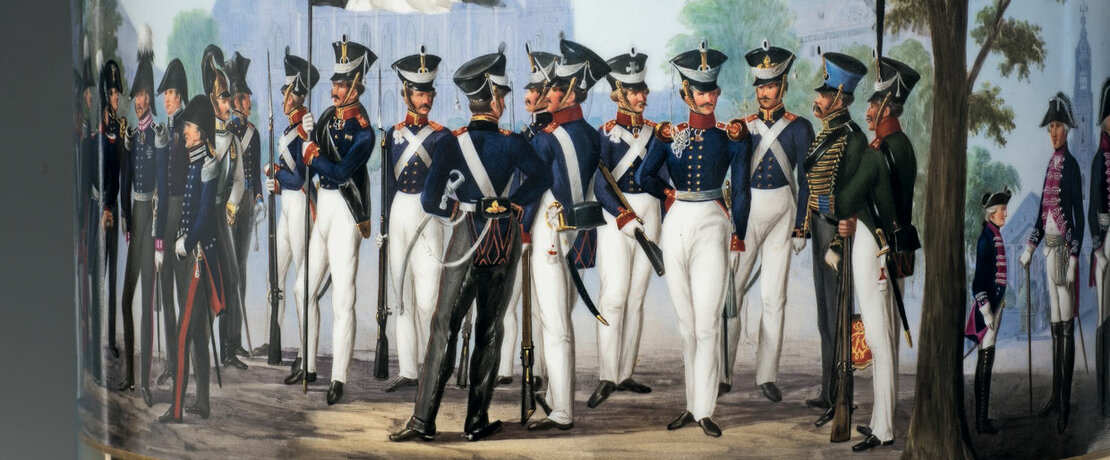
The collection of the New York businessman Richard Baron Cohen is without doubt the world’s largest and most important private porcelain collection of the first half of the 19th century. Excepting the Hermitage in St. Petersburg, there is no comparable overview of European porcelain production from the beginning of the 19th century. The passionate collector travelled the world over the years acquiring top pieces as well as imperially commissioned pieces of the Berlin, Sèvres and Viennese manufacturers.
The Twinight Collection has been exhibited in the Metropolitan Museum of Art in New York, the Liechtenstein Museum in Vienna as well as in Schloss Charlottenburg in Berlin, and clearly demonstrates the exchange of knowledge as well as the technical and artistic connections of the leading European porcelain manufacturers of that period. The mutual influence of the manufacturers from around the turn of the century manifested itself in diverse services with various themes. Napoleon’s expeditions on the Nile from 1798-1801, for example, inspired nearly all manufacturers to produce forms and decoration in the Egyptian style, whilst the fashion for cameo painting, based on the illusion of stone carving, was an optic that could be perfectly imitated and was cultivated equally by all three manufacturers.
Highlights of KPM – Königliche Porzellan Manufaktur
The most expensive object in the auction at 200,000 - 250,000 euro is a KPM vase, Munich form no. 2 with eight views of Berlin. An entry in the imperial "Conto-Buch" (accounts book), corroborates that the 60 cm high vase was intended as a birthday gift for the Crown Prince Maximilian II in 1838. The marriage of the Prussian Crown Prince Friedrich Wilhelm IV to Princess Elisabeth von Bayern in 1823 had ignited a cultural interaction with the exchange of imperial gifts, some adorned with Prussian city views and some with motifs of the Bavarian Alps.
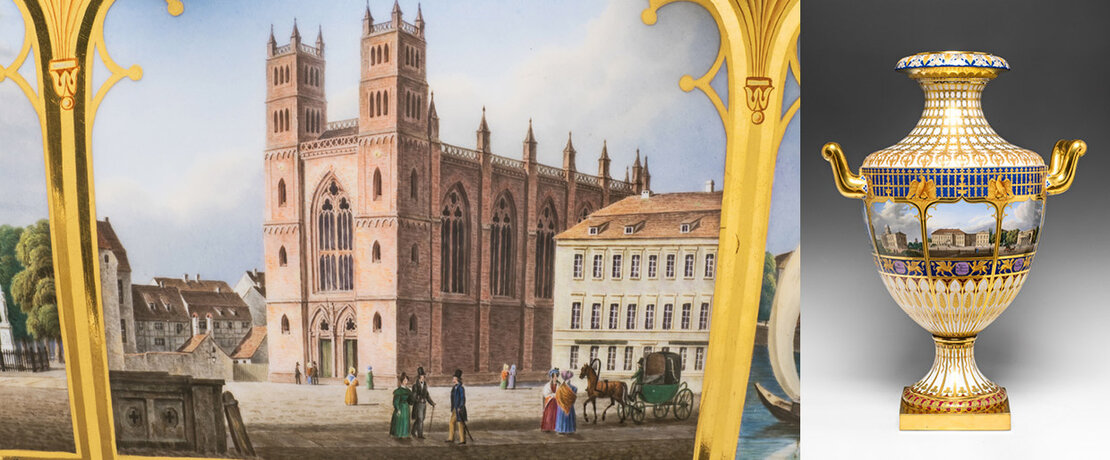
Berlin, KPM, around 1838, the decoration design by Carl August Menzel after a pattern by Carl Daniel Freydanck and Johann Christian August Walter. Height 62 cm, width across handles 44 cm.
€ 200,000 – 250,000
Another important and high value item in the auction is a further KPM vase featuring the battle of Vitoria from 1817, with an estimate of 150,000 - 200,000 euro. Following the Wars of Liberation against Napoleon Bonaparte, Friedrich Wilhelm III commissioned numerous works from KPM for meritorious Britons. The same vase depicting the battle in Basque Vitoria is known to have been presented to the Duke of Wellington and resides today in Apsley House.
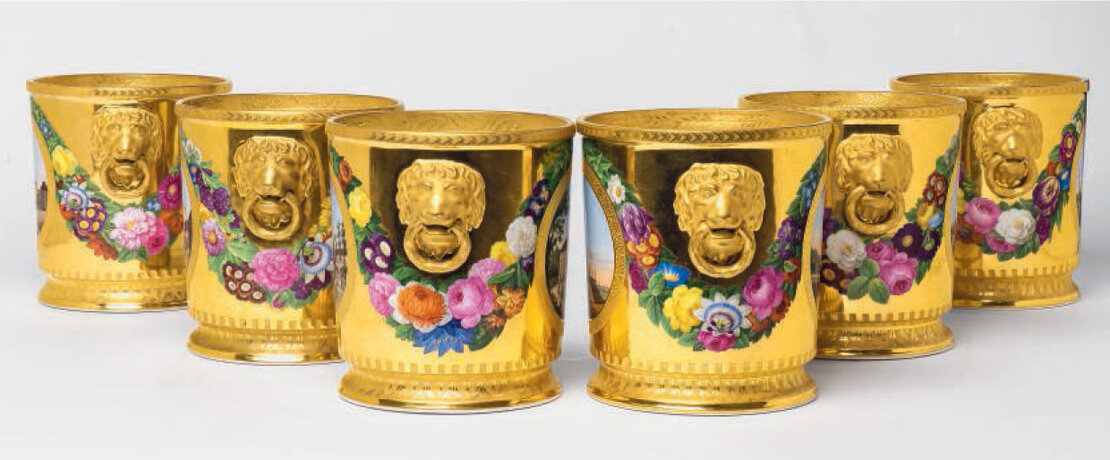
Berlin, KPM, 1825. Height circa 20 cm, diameter circa 18 cm.
Each € 40,000 – 60,000
Further highlights include three pairs of bottle coolers from the wedding service of Princess Luise von Preußen and Prince Friedrich der Niederlande (each pair 40,000 - 60,000 euro). In accordance with the tradition of the Prussian court, Friedrich Willhelm III's daughter received a comprehensive dinner and dessert service by KPM decorated with topographical views of the Prussian kingdom. The motifs of Berlin architecture and Charlottenburg's Schlosspark would have been treasured reminders of places from Princess Luise's childhood.
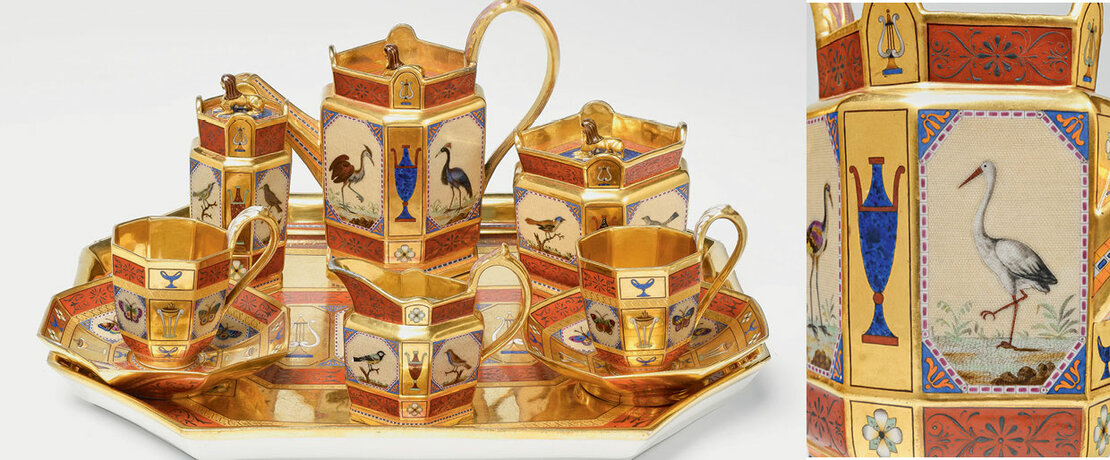
€ 60,000 – 80,000
With an estimate of 60,000 - 80,000 euro, a rare service on a tray featuring micro-mosaic painting (from around 1815) is a further piece highlighting the uniqueness of the Twinight Collection. Through the work of Johann Joachim Winckelmann, the technique of micro-mosaic and marquetry-like processing of semi-precious stones (commesso in pietre dure) came back into fashion in Florence in the second half of the 18th century. The opificio di pietre dure fulfilled large commissions for royal houses and wealthy collectors, but also produced small tourist objects which could be brought home as souvenirs from the Grand Tour. The Prussian imperial house's love for the antique, but perhaps also for the products of the competition - those of the manufactory of Josiah Wedgwood - prompted KPM to react against this fashion. The focus was on creating a product that was fashionable but still looked precious in every detail - a risky and costly undertaking. It is worth noting that the manufactory did not use any printing aids at all in the porcelain painting: every stone was individually painted. The design of the form is also unusual, elegantly and excitingly linking the influences of Roman antiquity with Egyptian elements. The ensemble can still be classed as a rarity today, a highlight of the porcelain art of KPM in the reign of Friedrich Wilhelm III.
Another rarity is a small painting of a view of a knight's hall (estimate 30,000 - 50,000 euro). The 29 x 33 cm porcelain panel was commissioned from the Swedish artist Theophron Kjellberg by Friedrich Wilhelm IV and is a testament to unparalleled precision.
Highlights of the manufacture nationale de Sèvres
The offering includes a rare plate from the Service des Départements from the year 1828 and is estimated at 15,000 - 20,000 euro. The director of the Sèvres manufactory, Alexandre Brongniart, originally designed this dessert service for a sovereign: firstly for Karl X, and later for Louis Philippe. Today the majority of plates are in the French state departments as well as museums in Paris and New York.
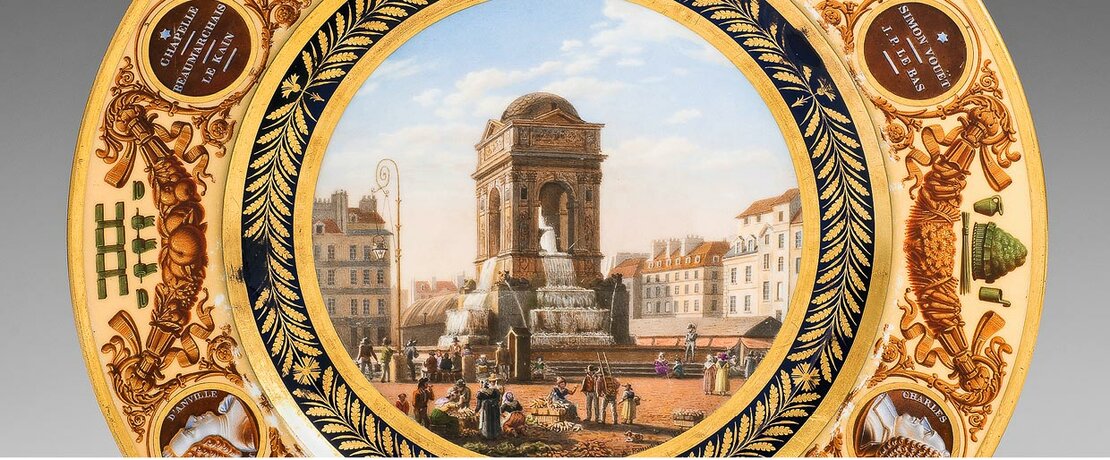
Sèvres, 1828, painted by Antoine Achille Poupart. Diameter 23.7 cm.
€ 15,000 – 20,000
Also of particular interest is a 24 x 18.4 cm porcelain picture with a portrait of Napoleon I in coronation regalia from the year 1806, with an estimate of 30,000 - 50,000 euro.
Another highlight shining amongst the Sèvres pieces is a plate with a cameo portrait of Aeneas, according to the myth, the ancestor of Romulus and Remus and thus ancestor of the eternal city (estimate 6,000 - 8,000 euro).
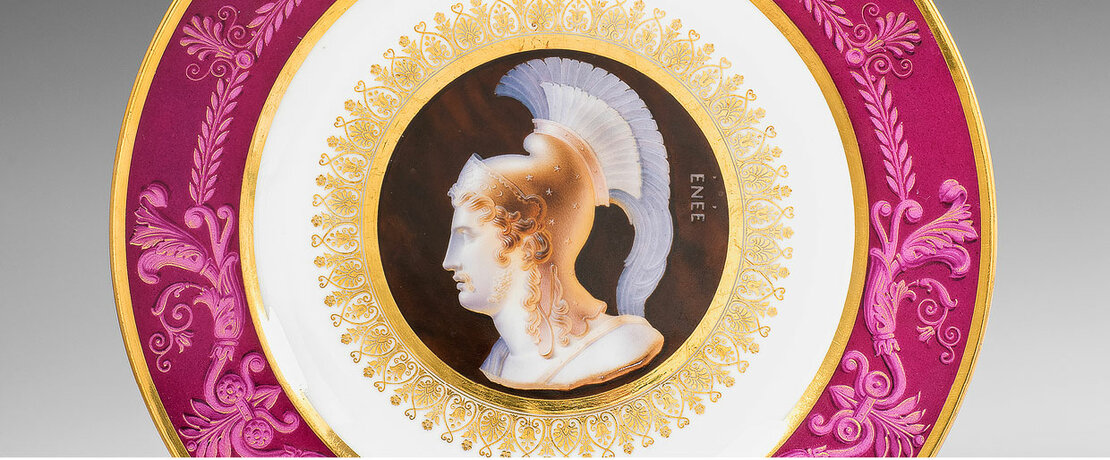
Sèvres, 1823. Diameter 23.6 cm
€ 6,000 – 8,000
Also offered for sale are a total of six plates from the Service Pêches, each set at 4,000 - 6,000 euro. The Service Pêches was first introduced on 1 May 1840 with seven plates, each with a different motif. Ambroise Louis Garneray (1783-1857) provided the patterns for the motifs. A marine painter and copper engraver with an adventurous lifestyle, his father was a pupil of Jacques Louis David. As a youngster, Ambroise spent little time in France, leaving at the age of 13 on a ship to India. Later he served on the Belle Poule where he was captured by the British in 1806. Back in France after the fall of Napoleon he began his painting career which also led him to Sèvres where his subjects were met with great interest. In October 1838 he signed a contract with the porcelain company, initially for the marine service, with the Service Pêches extended in 1846 to the theme of Pêches maritimes. Not only plates with this motif became available, but also compotières and shell-shaped dishes. It remained in production until 1852.
Highlights of the Vienna porcelain manufactory
Particularly noteworthy in this section is Déjeuner with views of Imperial Castles in Vienna and surroundings from 1816-17, offered for 30,000 - 40,000 euro. As the Bavarian lozenge band implies, the unusual service was probably produced on the occasion of the marriage of the Austrian emperor Franz I to Karoline Auguste von Bayern (1792-1873).
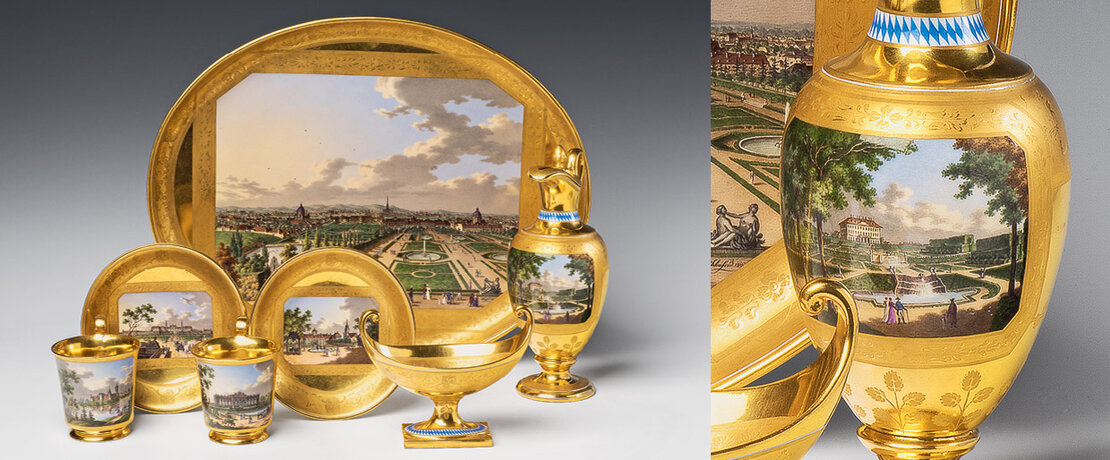
€ 30,000 – 40,000
A further top lot takes the form of a three-piece writing set with views of Vienna from 1826, painted by Jakob Schufreid, and verified as an imperial commission. In the inventory of the "Im Militär im Jahre 1828 an Seine k:k: apost. Majestät dem Kaiser abgegangenen und unberichtiget gebliebenen Gegenstände", the writing set is noted on 1 October as a gift "Für seine königliche Hoheit, den Bruder Seiner Majestät des Königs von Preußen". The emperor paid 120 gulden for the writing set from his coffer. (Lehner Jobst, ibd., p. 370) Three princes could be considered as recipients: Heinrich (1781-1846), Wilhelm (1783-1851) and Friedrich Wilhelm Graf von Brandenburg (1792-1850, from the morganatic marriage of Friedrich Wilhelm II to Sophie von Dönhoff) (estimate 10,000 - 15,000 euro).
Estimated at 10,000 - 15,000 euro, the panel with Viennese cameo painting is attributed to the painter Lorenz Herr. The panel depicts the famous Gemma Augustea, a Roman stone carving dated to the early imperial age 9-12 A.D. in the collection of cameos and gems in the Kunstistorisches Museum in Vienna. Joseph Calasanz, the Knight of Arneth, published the gem, considered the cameo par excellence, after a drawing by Fendi 1849 in "Die antiken Cameen des k. k. Münz- u. Antiken-Cabinettes". This unusual panel was made over 30 years before this publication was released, which, as one of the most important pieces of the Vienna porcelain manufactory under the direction of Conrad von Sorgenthal, documents the state of cameo painting.
The Tête à tête in Egyptian style from the years 1799-1802 is estimated at 15,000 - 20,000 euro and consists of an oval panel with a grid border, a decanter in the form of an Egyptian canopic jug, an oval lidded box with a three-dimensional finial in the form of a crocodile, a round lidded box with two handles and a sphinx-shaped finial as well as two cups and saucers.
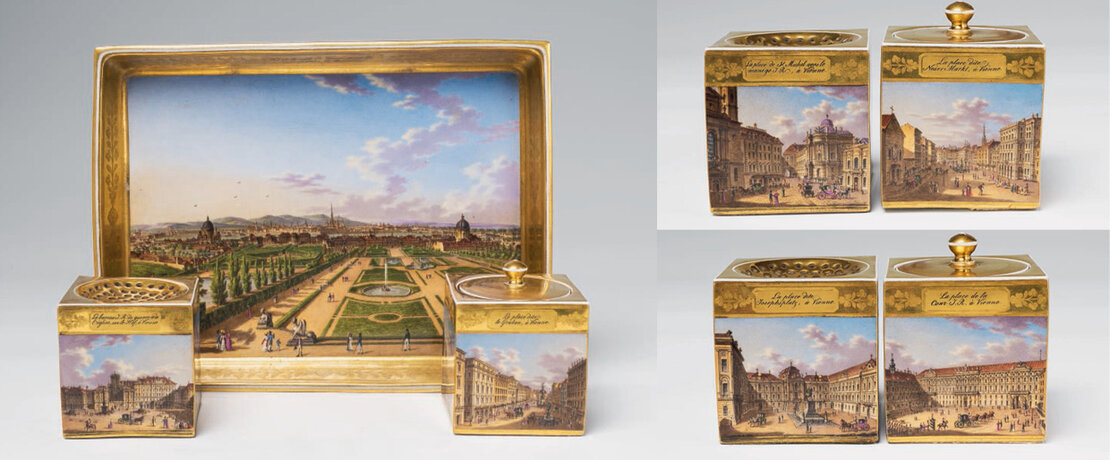
€ 10,000 – 15,000
The Tête à tête in Egyptian style from the years 1799-1802 is estimated at 15,000 - 20,000 euro and consists of an oval panel with a grid border, a decanter in the form of an Egyptian canopic jug, an oval lidded box with a three-dimensional finial in the form of a crocodile, a round lidded box with two handles and a sphinx-shaped finial as well as two cups and saucers.
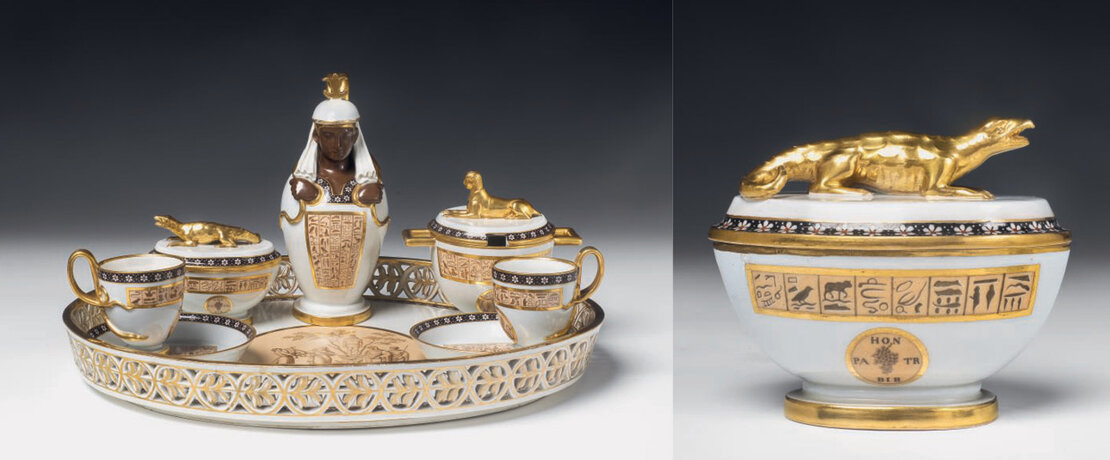
€ 15,000 – 20,000
